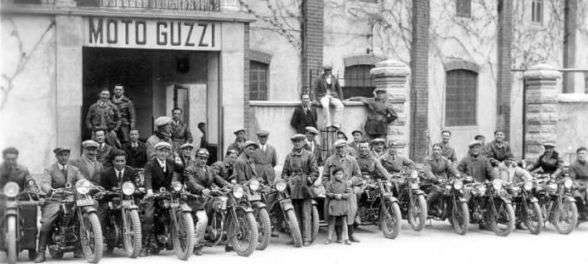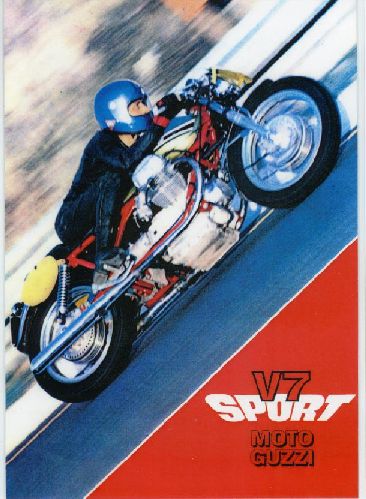Site: Danish | English
History
Technical : The complex stuff - exciting but heavy reading, take your time.
Please contact Gregory Bender with any questions, corrections, or suggestions for improvement.
History
Do not expect to learn all about Moto Guzzi's history from World War 1 to present time on this page. Other people have told the story in a number of fine books, so buy one of these if you want to get deeper insight.
I will concentrate on the part of the company's history that contains the development of the classical Guzzi with the big V-engine and the Tonti frame..
The picture below is an exception. I included it on the page because I think it's a nice picture. That's why !

Engine:
In the early 1960'ies the Italian authorities was looking for a new motorcycle for military and police duty. Until then they had used the single cylinder 500 cc Moto Guzzi, but it was no longer powerful enough to keep ahead of the ever faster traffic.
The governmental contracts was very important for Moto Guzzi's earning (the factory's economy was as bad as it used to be), so it was significant for Moto Guzzi to keep the government as a customer. However, in these days, most Italian Motorcycle manufactures (including Moto Guzzi) was controlled by the government, so it wasn't possible or allowed to favorise a single factory by just handing over a new contract to Moto Guzzi. In stead the government chose to write out a contest. Manufactures (Italian of course) that wanted to participate was to construct a new motorcycle to be used for military/police duty, from the following (and several more) guidelines:
- A powerful motorcycle, able to run 100.000 kms without major overhauls, and easy to maintain without the need of special tools.
A contest like this was actually a very bright idea: the winner would naturally get a nice government contract, but the losers would all have a brand new bike to offer the public. Prototypes was to be ready for test in the spring of 1966.
At Moto Guzzi, Giulio Carcano and Umberto Todero was assigned to the task of designing a winner. Not a bad choice at all, they had worked together for years and was responsible for the design of the famous V8 racer that had a very short career in the 50'ies (It was banned because it was too fast). They discussed a number of different designs, but decided on the now well-known air cooled V-2 engine with shaft drive. The other participating factories all made their bet on chain driven parallel twins.
And now its time to kill a 20 years old myth:
- The V-2 engine for Moto Guzzi's motorcycles is not an improved military engine from a three wheeled tractor! It's correct that Moto Guzzi at a time produced a - ehh - thing like that, also with a V-2 engine, but it has absolutely nothing in common with the “new” construction.
The first prototype was ready in 1964, and all of 1965 was used for tests to be ready for the contest the following spring.
And the Guzzi made it well in all tests. The authorities started a long-term test to see if the bikes could stand the strain of 100.000 kms without breaking down, but after 31.000 the Guzzi had proved itself so superior that the government stopped the test. The Guzzi was also by far the easiest bike to service, so it wasn't difficult to pick a winner: Moto Guzzi got the contract.
Guzzi's own test riders drove another 55.000 kms on the bike before it was taken apart for inspection and there was no unpleasant surprises.
This is the engine that is still used on a Moto Guzzi today, its been developed and improved during the years, but the heritage goes straight back to the prototype from 1964.
Frame:
The V7 Ambassador/Special with the original twin loop frame was selling satisfactory, but in 1969 the Moto Guzzi board discussed the possibility to construct a faster and more sporty bike. The managing director expressed that the perfect motorcycle should be able to do 200 km/hour, have a max. weight of 200 kg, and a five speed gearbox.
Entering the stage is Lino Tonti: Like Carcano and Todero he a highly skilled engineer. He had previously constructed his own Linto racers and worked in the construction department at Bianchi and Aermacchi. He is quite aware that the engine could be developed to yield the necessary power, but the frame was a problem. It was to high, too heavy, and too flexible.
To lower the frame he had to modify the engine so the generator was moved from its high position in the “V”, to the end of the crankshaft. To achieve his goal of a low frame there must be room for the upper frame tubes between the cylinder heads.
Tonti teams up with a couple of friends, and they spends a couple of days in his private workshop to make a true masterpiece: The Tonti frame. Made by large diameter, straight tubes, welded together in triangles, it proves to be one of the most rigid motorcycle frames ever. The frame tubes run closely around the engine and makes the Guzzi of the lowest superbikes. Park it next to a BMW boxer and you'll think the German is some weird kind of two storey motorcycle.
Frame and engine put together becomes the V7 Sport, Ancestor of all Tonti framed Guzzi's.

The first approx. 200 bikes were build by hand in Moto Guzzi's Racing Department. The frame on these bikes were made in thin wall crome-moly tubing, and the engines were blue-printed for a somewhat higher output than later models in serial production.
These 0-series bikes is called “Telaio Rosso” (red frame) and are debatable the only sporty Guzzi's that can match the original wish from the board - 200 km/t, 200 kg, 5-speed gearbox. This doesn't make the ordinary models bad ones, they are just a tad heavier. A genuine Telaio Rosso today is very, very expensive and you'll almost never see them for sale.
